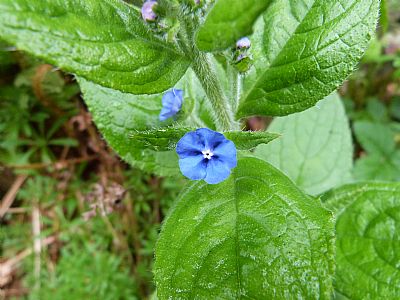ALKANET / GREEN ALKANET : Pentaglottis sempervirens
This attractive blue flower with dark green slightly spikey leaves is not native to the UK, but comes from south western Europe. We see batches of it growing on the banks of the upper Leven. The "green" in the name is misleading as that refers to their use as a dye.
Gardeners World tells us that :
Green alkanet (Pentaglottis sempervirens) is a vigorous, blue-flowered perennial with contrasting white 'eyes', native to south-west Europe. It grows and spreads prolifically but, in the right place, where it has room to spread and won’t out-compete other plants, it makes handsome ground cover where it attracts many species of wildlife.
Green alkanet flowers are edible and its roots can be used to make a red dye – indeed, the name ‘alkanet’ derives from the Arabic word for henna and may be linked to this use.
Although not a native species, it does appear in the Native Flower website which tells us :
It was introduced into the UK from continental Europe as a garden plant by the seventeenth century. The 'Green' refers to the evergreen leaves of the plant and 'Alkanet' indicates it is a plant traditionally used to make dyes. Green Alkanet is a bushy plant with large hairy and bluntly-toothed, oval leaves with pointed tips. Like other members of the Borage family, it has very bristly stems.
Botanic classification and naming: Green Alkanet is a member of the Borage (Boraginaceae) family. The genus name 'Pentaglottis' identifies the plant as a Alkanet and its species name 'sempervirens' means 'evergreen plant'.
Benefits: Caterpillars of the Scarlet Tiger moth feed on this plant.

A small blue attractive flower amidst large slightly spikey green leaves.
GARDENERS WORLD : https://www.gardenersworld.com/how-to/grow-plants/complete-guide-to-green-alkanet/#
NATIVE FLOWER website : https://www.nativeflower.co.uk/details.php?plant_url=132
WIKIPEDIA : https://en.wikipedia.org/wiki/Pentaglottis

